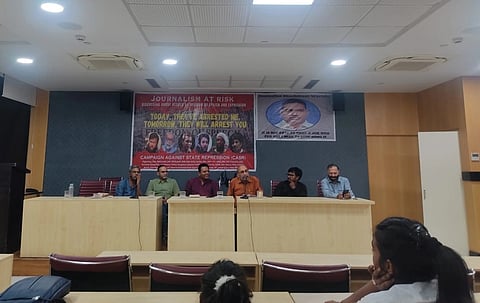
New Delhi— Journalism at Risk- Discussion About Attack on Freedom of Speech and Expression was a program organised by the Campaign Against State Repression on May 15 at Delhi's HKS Surjeet Bhavan.
The invited speakers covered a wide range of topics related to the ongoing attacks on journalists and independent media by the Indian government.
Professor N. Sachin, the discussion's moderator, began by paying tribute to the recently-murdered journalist Shashikant Warishe, who was assassinated in 2023 for writing articles critical of a refinery project in Ratnagiri. Sachin emphasized how the vulnerability of journalism is a more severe sign that society as a whole is vulnerable. He expressed concern over the loss of a sort of media that covers topics affecting people.
Even today there are certain independent journalists or even digital media houses who are trying to cover the ground topics affecting people but they aren’t able to gather the kind of support or audience as propaganda-based channels get.
The first speaker, Mandeep Punia a freelance journalist, discussed the partisanship and apathy of the media and how different media outlets, including the so-called "Godi media" and liberal media outlets, both address concerns that serve a corporate-state nexus.
He pointed out how this was evident when Delhi's liberal media outlets made no mention of the events in Punjab. He went into further detail on the third media format, which offers an alternative. Punia said that journalists covering the public interest must approach their work with an active mindset.
The following speaker an activist and Journalist, Bhasha Singh, emphasized how the Hindutva fascist essence of the state quietly conceals corporate resource theft and the function of capital.
Another renowned journalist Prashant Tandon discussed the need to distinguish between "corporate democracy" and "cosmetic democracy," particularly in India where Article 19 has acts like the UAPA that actively pave the way for the legal curtailment of journalists.
These acts have so-called "reasonable restrictions" existing in the law. He advocated for the creation of a broad statute protecting journalistic freedom in India. He said that although they may not be flawless, the United States and the European Union serve as useful models for such a law.
The topic of India's general and quick decline in press freedom rankings under the current rule was raised by Sandeep Rauzi of Workers Unity. He clarified that press freedom simply falls under the overall restriction of democratic rights throughout India. He advised workers' associations and people's media to establish labor beats in order to cover the working class's issues, which are often ignored in media discourse.
Many journalists from different backgrounds were a part of this discussion and they laid emphasis on important aspects of today’s situation in terms of democracy and freedom to pursue non-bias journalism.
You can also join our WhatsApp group to get premium and selected news of The Mooknayak on WhatsApp. Click here to join the WhatsApp group.